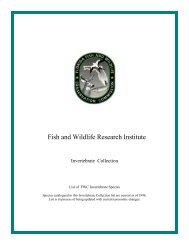STOCK ASSESSMENT OF WHITE GRUNT FROM THE WEST ...
STOCK ASSESSMENT OF WHITE GRUNT FROM THE WEST ...
STOCK ASSESSMENT OF WHITE GRUNT FROM THE WEST ...
You also want an ePaper? Increase the reach of your titles
YUMPU automatically turns print PDFs into web optimized ePapers that Google loves.
available, 1992-1998. The number of trips reporting landings of grunts made using traps has<br />
increased on the Atlantic coast and decreased on the Gulf coast. The number of Atlantic coast<br />
trips using traps increased from 45 in 1992 to 288 in 1998. In contrast, the Gulf coast trips using<br />
traps fell from 1,225 in 1992 to 593 in 1998. The total annual harvest made by these gear during<br />
1992-98 also followed these trends. Within the Gulf coast, few commercial trips in the<br />
Panhandle reported landing grunts with either traps or hook-and-line (Table 6). In the region<br />
from Wakulla through Pasco county, the numbers of trips reporting landings of grunts using<br />
hook-and-line gear or using traps was similar during 1992-1995 but has been increasingly<br />
dominated by hook-and-line gear since then. Despite the increase in hook-and-line trips, the<br />
number of pounds of ‘grunts’ landed by traps is still greater than that landed by hook-and-line.<br />
In the Pinellas-Collier region about ten times more trips were made with hook-and-line gear than<br />
with traps. This gear preference for hook-and-line gear was even more extreme in Monroe<br />
county during 1996-1998, with 2,000-3,000 hook-and-line trips and about 150 trap trips.<br />
The annual modal lengths for white grunt sampled from the commercial landings during<br />
TIP was 9 or 10” fork length for all years except 1994 when it was 12” (Fig. 10). Few white<br />
grunt were measured on the Atlantic coast but these also showed a modal fork length of 9 or<br />
10”. Occasional samples contained very large white grunt ranging from 20-30” FL. The modal<br />
weights of white grunt in the TIP samples were 0.7 and 0.5 pounds in 1997 and 1998,<br />
respectively, on the Atlantic coast (Fig. 11). On the Gulf coast modal weights were at 0.7<br />
pounds for both years.<br />
Recreational<br />
Marine Recreational Fisheries Statistics Survey (MRFSS)<br />
Estimated average annual landings of white grunt by non- headboat anglers during 1996-<br />
98 were about 217,000 fish on the Atlantic coast and 1,655,000 fish on the Gulf coast (Table 9).<br />
Atlantic coast landings were highly variable ranging from zero in 1988 to 528,000 in 1992. The<br />
number of white grunt caught and released alive was often similar to the number caught and<br />
landed (Fig. 12). On the Gulf coast, landings were less variable, with most estimates of annual<br />
landings during the period 1983-93 at about 2,000,000 fish. An exception to this was a very low<br />
estimate of 542,000 fish landed in 1986. During the three most recent years (1996-98) landings<br />
have been less than 2,000,000 fish. The numbers of white grunt released alive was often twice or<br />
more the number of white grunt landed on the Gulf coast.<br />
The majority of white grunt landed and sampled by MRFSS creel clerks ranged from 7-<br />
9” FL on the Atlantic coast and 7-12” on the Gulf coast (Table 10). Some of the very large fish,<br />
over about 26” FL in the Gulf coast data from MRFSS may be margate lengths instead of those<br />
of white grunt that are not known to get this large.<br />
Of the anglers who caught white grunt, few indicated to MRFSS creel clerks that they<br />
had been targeting white grunt. During the period 1982-1998, only 14 of 1,058 (1.3%) Atlantic<br />
angler-respondents said that they were fishing specifically to catch white grunts (Table 11). On<br />
the Gulf coast during this period only 3.8% (178/4372) anglers responded that they were fishing<br />
for white grunt. The estimated number of trips taken by anglers fishing from private or rental<br />
boats and targeting or catching white grunt was highest in the early 1990s on both coasts (Fig.<br />
13). The number of fishing trips has varied around 100,000 trips on the Atlantic coast over the<br />
11




